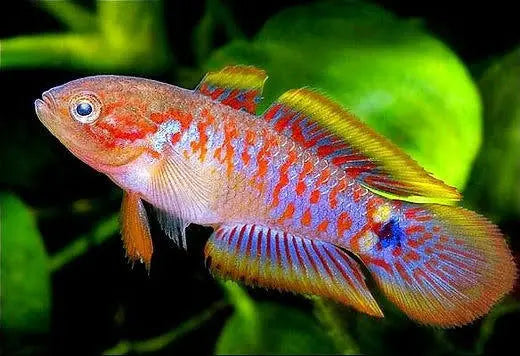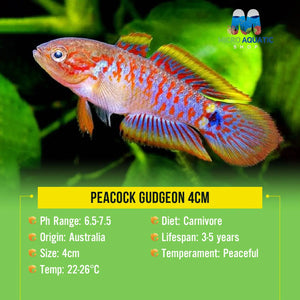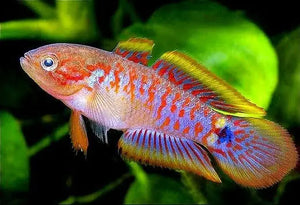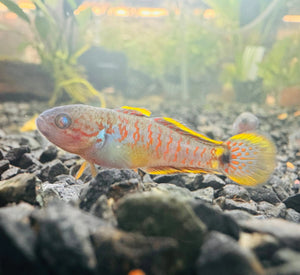Peacock Gudgeon
Guarantee Safe Checkout
Peacock Gudgeon (Tateurndina ocellicauda) - Colorful Freshwater Fish
Welcome to our journey into the world of the Peacock Gudgeon. This vibrant freshwater fish calls Australia's waterways home. We'll explore its natural habitat, unique looks, and what it needs to thrive in an aquarium. This guide is perfect for both new and experienced fish keepers looking to welcome the Peacock Gudgeon into their home.
Key Takeaways
- The Peacock Gudgeon, scientifically known as Tateurndina ocellicauda, is a stunning freshwater fish native to Australia.
- These fish are known for their vibrant colouration, which can range from shades of blue, green, and orange.
- To thrive in captivity, Peacock Gudgeons require specific water parameters and a well-planted aquarium setup.
- Successful breeding of Peacock Gudgeons can be a rewarding challenge for experienced aquarium hobbyists.
- Careful selection of tank mates is crucial to ensure the Peacock Gudgeon's well-being and peaceful community living.
Introduction to Tateurndina ocellicauda,Peacock Gudgeon
The Peacock Gudgeon, known scientifically as Tateurndina ocellicauda, is a stunning native fish from Australia's freshwaters. It's loved in the aquarium world for its bright looks and interesting ways. We'll look into why the Peacock Gudgeon is important in Australia and how we can protect it through sustainable aquaculture.  Found mainly in eastern Australia, the Peacock Gudgeon is considered vulnerable by the IUCN. This means we need to act fast to save it from dangers like habitat loss and invasive species. By choosing sustainable aquaculture, we help keep the Peacock Gudgeon safe and support its survival.
Found mainly in eastern Australia, the Peacock Gudgeon is considered vulnerable by the IUCN. This means we need to act fast to save it from dangers like habitat loss and invasive species. By choosing sustainable aquaculture, we help keep the Peacock Gudgeon safe and support its survival.
| Key Facts | Details |
| Scientific Name | Tateurndina ocellicauda |
| Common Name | Peacock Gudgeon |
| Conservation Status | Vulnerable |
| Native Range | Eastern Australia |
| Aquarium Trade Significance | Highly popular and sought-after |
Next, we'll dive into the Peacock Gudgeon's natural home, its looks, and how to care for it. This will help us understand how to protect it in both the wild and in sustainable aquaculture settings.
Natural Habitat and Distribution
The Peacock Gudgeon is a stunning freshwater fish from Australia. They live in different native species habitats across the country. These fish thrive in Australia's diverse freshwater fish ecosystems.
Native Australian Waters
The Peacock Gudgeon loves the coastal and inland waters of Australia. You can find them in slow streams, rivers, lakes, and wetlands in the east and north.
Preferred Environmental Conditions
- They like waters with a gentle flow and lots of plants. This gives them places to hide and find food.
- They do best in slightly acidic to neutral waters, with a pH of 6.5 to 7.5. The temperature should be between 22-28°C.
- These fish need well-oxygenated water. They can't handle poor water quality or low oxygen.
Natural Behaviour in the Wild
In the wild, Peacock Gudgeons show interesting behaviors. They are peaceful and social, often staying in small groups, especially when young. They are good at hiding in plants and underwater structures.
| Behavioral Trait | Description |
| Shoaling | Peacock Gudgeons often form small, cohesive shoals, especially when young, for protection and social interaction. |
| Hiding and Shelter-Seeking | These fish frequently seek refuge among aquatic plants, rocks, or other underwater structures, using them as hiding spots and to avoid predators. |
| Foraging | Peacock Gudgeons are omnivorous and feed on a variety of small invertebrates, algae, and plant matter found in their natural habitats. |
Physical Characteristics and Appearance
The Peacock Gudgeon (Tateurndina ocellicauda) is a stunning freshwater fish found in many aquariums. Its bright colours and patterns make it a joy to watch. Let's look at what makes the Peacock Gudgeon special among aquarium fish. The Peacock Gudgeon has a small, sleek body that can reach 6 centimetres long. Its most striking feature is the large, eyespotted dorsal fin. This fin looks like a peacock's feathers, with blues, greens, and yellows that catch the eye. The body of the Tateurndina ocellicauda is a mix of browns, tans, and greys. It also has flashes of blue and green on the sides. The fins on the belly and tail add to the fish's striking look.
- Compact, streamlined body up to 6 cm in length
- Prominent, eyespotted dorsal fin resembling a peacock's plumage
- Mottled body colouration of browns, tans, and greys with iridescent blues and greens
The Peacock Gudgeon's unique looks and bright colours make it stand out among aquarium fish. Its beautiful appearance will surely grab the attention of any aquarist who's lucky enough to have it.
Setting Up the Perfect Aquarium Environment
Keeping aquarium fish like the stunning Peacock Gudgeon requires the right setup. We're here to help you create the perfect home for your Peacock Gudgeons. This is key for their health and wellbeing.
Tank Size Requirements
Peacock Gudgeons need plenty of space to swim. A 20-gallon (75-litre) tank is the minimum for one fish. For a small school, a 30-gallon (115-litre) or larger tank is needed.
Water Parameters
These fish love soft, slightly acidic water. Aim for a pH of 6.0 to 7.5 and a temperature of 72-82°F (22-28°C). Regular water changes are important to keep the water quality high.
Substrate and Decoration Choices
- Substrate: Sand or small gravel is best. Peacock Gudgeons enjoy digging in it.
- Decorations: Add hiding spots like rock formations, driftwood, and dense plants. This makes them feel safe and encourages natural behaviour.
- Lighting: They prefer moderate lighting. Bright lights can be too much for them.
By setting up the aquarium to meet Peacock Gudgeons' needs, you'll create a great habitat. This allows these amazing fish to thrive and enjoy their natural environment.
Breeding and Reproduction
We love the colorful world of ornamental fish. The Peacock Gudgeon is especially beautiful and interesting to breed. We'll explore how to breed them, helping conservation and sustainable aquaculture.  Peacock Gudgeons have amazing courtship rituals. Males show off with bright colors during breeding. They attract females with their stunning looks. To breed them, you need a well-planted tank with soft, slightly acidic water. Females lay eggs on plants, and males fertilize them. After hatching, the fry need careful care and a special diet.
Peacock Gudgeons have amazing courtship rituals. Males show off with bright colors during breeding. They attract females with their stunning looks. To breed them, you need a well-planted tank with soft, slightly acidic water. Females lay eggs on plants, and males fertilize them. After hatching, the fry need careful care and a special diet.
- Provide a densely planted aquarium with calm water movement to mimic the natural habitat.
- Maintain water parameters within the optimal range for Peacock Gudgeons, including slightly acidic pH and soft water.
- Offer a variety of live and high-quality commercial foods to nourish the developing fry.
- Carefully monitor and protect the fry from predation to maximize survival rates.
By learning about Peacock Gudgeon breeding, we help conserve this species. We support the ornamental fish trade with responsible aquarium practices. This way, we ensure these beautiful fish thrive for years to come.
Diet and Feeding Requirements
It's key to give Peacock Gudgeons the right food for their health and colour. As fans of freshwater fish, we know a varied diet is vital. It meets their natural needs.
Live Foods
Peacock Gudgeons love to eat live foods. Some great options are:
- Brine shrimp
- Bloodworms
- Daphnia
- Tubifex worms
These foods are full of nutrients. They also let the fish hunt, keeping them active and happy in their aquarium fish home.
Commercial Foods
But live foods aren't the only thing they eat. We can also give them aquarium fish flakes or pellets. Choose ones made for freshwater fish with the right mix of nutrients.
Feeding Schedule
To keep them healthy and colourful, feed them two to three times a day. Give a small amount they can eat in a few minutes. This stops food from spoiling the water. By giving them a varied diet, we help these beautiful freshwater fish. They thrive in our home aquariums, showing off their stunning colours.
Tank Mates and Community Setup
Peacock Gudgeons are lively aquarium fish that add to a lively freshwater fish community. It's key to pick tank mates that match their calm nature, size, and habitat needs. These Australian fish thrive with peaceful, community-loving species. Some great tank mates for Peacock Gudgeons include:
- Other small, peaceful cyprinids like danios, rasboras, and small barbs
- Corydoras catfish, which share their bottom-dwelling habits
- Gentle tetras, such as cardinal or ember tetras
- Peaceful live-bearing fish like guppies or mollies
Stay away from aggressive or big fish that might bully or eat your Peacock Gudgeons. For a peaceful community, mix peaceful, similar-sized fish. This way, they can live together without stress or fights.
| Recommended Tank Mates | Traits |
| Danios, Rasboras, Small Barbs | Peaceful, Community-Oriented |
| Corydoras Catfish | Bottom-Dwelling, Peaceful |
| Cardinal Tetras, Ember Tetras | Peaceful, Shoaling Behavior |
| Guppies, Mollies | Peaceful, Live-Bearing |
By choosing the right tank mates and mimicking their natural home, you can build a vibrant aquarium fish community. This community will highlight the charm and spirit of Peacock Gudgeons.
Conclusion
The Peacock Gudgeon, or Tateurndina ocellicauda, is a stunning freshwater fish from Australia. Its bright colours and special behaviour make it a joy to watch. It also plays a key role in our water ecosystems.  We can help the Peacock Gudgeon thrive by keeping aquariums responsibly. We need to create the right home for them and meet their food and social needs. This way, we can help these endangered fish live well. Let's cherish the beauty and importance of the Peacock Gudgeon. Together, we can protect this amazing fish in Australia's underwater world. This way, future generations can also enjoy its beauty.
We can help the Peacock Gudgeon thrive by keeping aquariums responsibly. We need to create the right home for them and meet their food and social needs. This way, we can help these endangered fish live well. Let's cherish the beauty and importance of the Peacock Gudgeon. Together, we can protect this amazing fish in Australia's underwater world. This way, future generations can also enjoy its beauty.
FAQ
What is the Peacock Gudgeon (Tateurndina ocellicauda)?
The Peacock Gudgeon, also known as Tateurndina ocellicauda, is a vibrant freshwater fish from Australia. It's loved by aquarium fans for its bright colours and unique look.
Where can the Peacock Gudgeon be found in the wild?
You can find the Peacock Gudgeon in certain Australian waterways. They like slow-moving streams, rivers, and wetlands. These places have lots of plants and rocky bottoms.
What are the physical characteristics of the Peacock Gudgeon?
The Peacock Gudgeon is a small fish, growing up to 8 cm long. They have bright colours like blues, greens, and oranges. They also have a special eye-like spot on their tail.
What are the ideal water parameters for keeping Peacock Gudgeons in an aquarium?
Peacock Gudgeons need well-oxygenated, slightly acidic to neutral water. The temperature should be between 22-28°C. They like a planted aquarium with hiding spots and soft, sandy ground.
Can Peacock Gudgeons be bred in captivity?
Yes, breeding Peacock Gudgeons in captivity is possible. But it's tricky. They need specific water and a special breeding setup to spawn and care for their fry.
What should I feed my Peacock Gudgeons?
Peacock Gudgeons eat a mix of live and prepared foods. In the wild, they eat small invertebrates, algae, and plants. In tanks, give them live foods like brine shrimp and bloodworms, along with good quality flakes or pellets.
What are some suitable tank mates for Peacock Gudgeons?
Peacock Gudgeons can live with peaceful, community-friendly fish. Good tank mates include small tetras, rasboras, and corydoras catfish. But avoid aggressive or big fish that might bother or compete with them.
| Quantity |
1 peacock gudgeon 2-3cm |
|---|






